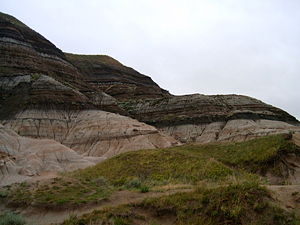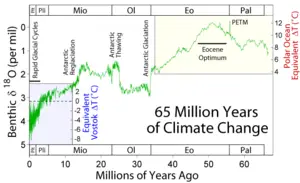Difference between revisions of "Paleogene" - New World Encyclopedia
m (Robot: Automated text replacement (-ISBN: +ISBN)) |
m ({{Paid}}) |
||
| Line 1: | Line 1: | ||
| − | {{Approved}}{{Images OK}}{{Submitted}}{{Contracted}} | + | {{Paid}}{{Approved}}{{Images OK}}{{Submitted}}{{Contracted}} |
The '''Paleogene''' (alternatively '''Palaeogene''') period is a major division of the [[geologic time scale]] and the first of two periods that mark our current era, the [[Cenozoic]]. The Paleogene began 65.5 ± 0.3 million years ago (mya) and ended 23.03 ± 0.05 mya. The Paleogene begins at the end of the [[Cretaceous]] period and is followed by the [[Neogene]] period, the current and final period of the Cenozoic. The Paleogene encompasses the [[Paleocene]], [[Eocene]], and [[Oligocene]] epochs. | The '''Paleogene''' (alternatively '''Palaeogene''') period is a major division of the [[geologic time scale]] and the first of two periods that mark our current era, the [[Cenozoic]]. The Paleogene began 65.5 ± 0.3 million years ago (mya) and ended 23.03 ± 0.05 mya. The Paleogene begins at the end of the [[Cretaceous]] period and is followed by the [[Neogene]] period, the current and final period of the Cenozoic. The Paleogene encompasses the [[Paleocene]], [[Eocene]], and [[Oligocene]] epochs. | ||
Revision as of 18:25, 27 December 2006
The Paleogene (alternatively Palaeogene) period is a major division of the geologic time scale and the first of two periods that mark our current era, the Cenozoic. The Paleogene began 65.5 ± 0.3 million years ago (mya) and ended 23.03 ± 0.05 mya. The Paleogene begins at the end of the Cretaceous period and is followed by the Neogene period, the current and final period of the Cenozoic. The Paleogene encompasses the Paleocene, Eocene, and Oligocene epochs.
The Tertiary was one prominent as the period that began at the end of the Cretaceous period. While its use has been widespread and continues, the International Commission on Stratigraphy no longer endorses this term as part of the formal stratigraphic nomenclature. When the term Tertiary is used now, it is generally as a "sub-era," which includes the Paleogene and part of the Neogene, rather than a "period" of geologic time (Hinton 2006). The Quaternary likewise has been subsumed into the Neogene and considered a "sub-era," although this remains quite controversial; the change has been opposed by many geologists, botanists, zoologists, and others (Hinton 2006).
The end of the Cretaceous period and the beginning of the Paleogene (originally Tertiary) was marked by a mass extinction event known as the Cretaceous-Tertiary extinction event. Also known as the K-T extinction event, it was a period of massive extinction of species that occurred about 65.5 million years ago, including most dinosaurs. Some recognize this mass extinction now as occurring at the Cretaceous-Paleogene boundary rather than the K-T boundary (Hinton 2006).
Another major phenomena during the Paleogene was one of the most significant periods of global change during the Cenozoic, the Paleocene-Eocene Thermal Maximum.
The Paleogene climate, geography, geology, and biota came on the foundation of previous stages and was itself the foundation for modern life. Lasting 42 million years, the Paleogene period is most notable as being the time in which mammals became very diversified and dominant.
| Cenozoic era (65-0 mya) | |
|---|---|
| Paleogene | Neogene Quaternary |
| Paleogene period | ||
|---|---|---|
| Paleocene epoch | Eocene epoch | Oligocene epoch |
| Danian | Selandian Thanetian |
Ypresian | Lutetian Bartonian | Priabonian |
Rupelian | Chattian |
Lower boundary: The Cretaceous-Tertiary extinction event
The Paleogene period immediately followed the mass extinction event at the end of the Cretaceous, known as the Cretaceous-Tertiary extinction event or K-T extinction event. Many forms of life perished, encompassing approximately 50 percent of all plant and animal families, the most conspicuous being the non-avian dinosaurs. The last of the pterosaurs also vanished, as well as the great sea reptiles of the Cretaceous, the mosasaurs and plesiosaurs. Mammals suffered as well, and among mollusks, the ammonites, a diverse group of coiled cephalopods, were exterminated. As much as 57 percent of the plant species in North America may have become extinct as well.
The K-T boundary that marks the separation between Cretaceous and Paleogene is visible in the geological record of much of the Earth by a discontinuity in the fossil fauna, with high iridium levels. There is also fossil evidence of abrupt changes in plants and animals. There is some evidence that a substantial but very short-lived climatic change may have occurred in the very early decades of the Paleocene. There are a number of theories about the cause of the K-T extinction event, with most evidence supporting the impact of a 10 km diameter asteroid near Yucatan, Mexico.
Paleocene-Eocene Thermal Maximum
The end of the Paleocene (55.5/54.8 Ma) was marked by one of the most significant periods of global change during the Cenozoic, a sudden global change. In an event marking the start of the Eocene, the planet heated up in one of the most rapid and extreme global warming events recorded in geologic history. This event is variously labeled the Paleocene-Eocene Thermal Maximum (PETM) or the Initial Eocene Thermal Maximum (IETM). During this time, sea surface temperatures rose between 5 and 8°C over a period of a few thousand years, and in the high Arctic, sea surface temperatures rose to a sub-tropical ~23°C/73°F. This upset oceanic and atmospheric circulation and led to the extinction of numerous deep-sea benthic foraminifera and on land, a major turnover in mammals.
Paleogene climate and paleogeology
Some continental motion took place during the Paleogene. Climates cooled somewhat over the duration of the Paleogene and inland seas retreated from North America early in the period.
There appears to have been a land bridge in the early Oligocene between North America and Europe as the faunas of the two regions are very similar (Mayr 2001).
Paleogene biota
The Paleogene period is most notable as being the time in which mammals evolved from small, simple forms into diverse animals in the wake of the mass extinction that ended the preceding Cretaceous period. Some of these mammals would evolve into large forms that would dominate the land, while others would become capable of living in marine, specialized terrestrial, and even airborne environments. Within a geologically brief period of time in the early Eocene, most of the modern mammal orders appeared
Birds also evolved considerably during this period changing into roughly-modern forms.
Most other branches of life on earth remained relatively unchanged in comparison to birds and mammals during this time period.
ReferencesISBN links support NWE through referral fees
- Hinton, A. C. 2006. Saving Time. BlueSci Online. (accessed December 3, 2006).
- Hooker, J. J. 2005. Tertiary to present: Paleocene. In R. C. Selley, L. R. McCocks, and I. R. Plimer, Encyclopedia of Geology, Vol. 5, pp. 459-465. Oxford: Elsevier Limited. ISBN 0-12-636380-3.
- Mayr, E. 2001. What Evolution Is. New York: Basic Books. ISBN 0-465-04425-5.
See also
Credits
New World Encyclopedia writers and editors rewrote and completed the Wikipedia article in accordance with New World Encyclopedia standards. This article abides by terms of the Creative Commons CC-by-sa 3.0 License (CC-by-sa), which may be used and disseminated with proper attribution. Credit is due under the terms of this license that can reference both the New World Encyclopedia contributors and the selfless volunteer contributors of the Wikimedia Foundation. To cite this article click here for a list of acceptable citing formats.The history of earlier contributions by wikipedians is accessible to researchers here:
The history of this article since it was imported to New World Encyclopedia:
Note: Some restrictions may apply to use of individual images which are separately licensed.

